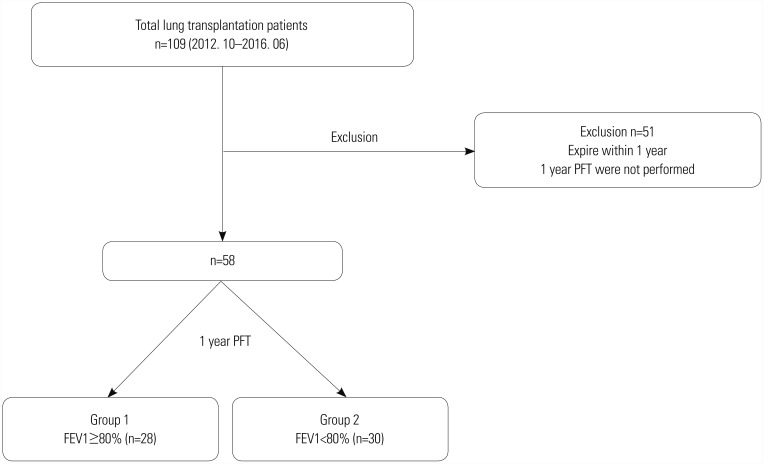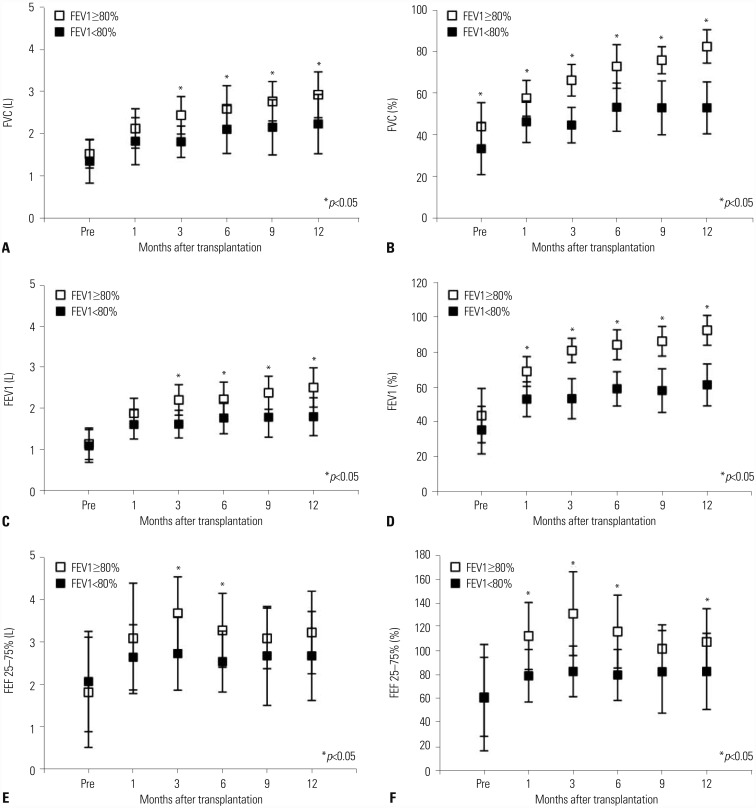Yonsei Med J.
2018 Nov;59(9):1088-1095. 10.3349/ymj.2018.59.9.1088.
Factors Associated with Lung Function Recovery at the First Year after Lung Transplantation
- Affiliations
-
- 1Division of Pulmonology, Department of Internal Medicine, Severance Hospital, Institute of Chest Diseases, Yonsei University College of Medicine, Seoul, Korea. dobie@yuhs.ac
- 2Department of Thoracic and Cardiovascular Surgery, Severance Hospital, Yonsei University College of Medicine, Seoul, Korea.
- KMID: 2422494
- DOI: http://doi.org/10.3349/ymj.2018.59.9.1088
Abstract
- PURPOSE
Post-operative pulmonary function is an important prognostic factor for lung transplantation. The purpose of this study was to identify factors affecting recovery of forced expiratory volume in 1 second (FEV1) at the first year after lung transplantation.
MATERIALS AND METHODS
We retrospectively reviewed the medical records of lung transplantation patients between October 2012 and June 2016. Patients who survived for longer than one year and who underwent pulmonary function test at the first year of lung transplantation were enrolled. Patients were divided into two groups according to whether they recovered to a normal range of FEV1 (FEV1 ≥80% of predicted value vs. < 80%). We compared the two groups and analyzed factors associated with lung function recovery.
RESULTS
Fifty-eight patients were enrolled in this study: 28 patients (48%) recovered to a FEV1 ≥80% of the predicted value, whereas 30 patients (52%) did not. Younger recipients [odds ratio (OR), 0.92; 95% confidence interval (CI), 0.87-0.98; p=0.010], longer duration of mechanical ventilator use after surgery (OR, 1.14; 95% CI, 1.03-1.26; p=0.015), and high-grade primary graft dysfunction (OR, 8.08; 95% CI, 1.67-39.18; p=0.009) were identified as independent risk factors associated with a lack of full recovery of lung function at 1 year after lung transplantation.
CONCLUSION
Immediate postoperative status may be associated with recovery of lung function after lung transplantation.
MeSH Terms
Figure
Reference
-
1. Toronto Lung Transplant Group. Unilateral lung transplantation for pulmonary fibrosis. N Engl J Med. 1986; 314:1140–1145. PMID: 3515192.2. Chambers DC, Yusen RD, Cherikh WS, Goldfarb SB, Kucheryavaya AY, Khusch K, et al. The registry of the International Society for Heart and Lung Transplantation: thirty-fourth adult lung and heart-lung transplantation report-2017; focus theme: allograft ischemic time. J Heart Lung Transplant. 2017; 36:1047–1059. PMID: 28784324.
Article3. Yusen RD, Edwards LB, Kucheryavaya AY, Benden C, Dipchand AI, Dobbels F, et al. The registry of the International Society for Heart and Lung Transplantation: thirty-first adult lung and heartlung transplant report--2014; focus theme: retransplantation. J Heart Lung Transplant. 2014; 33:1009–1024. PMID: 25242125.
Article4. Laporta Hernández R, Lázaro Carrasco MT, Varela de Ugarte A, Ussetti Gil P. Long-term follow-up of the lung transplant patient. Arch Bronconeumol. 2014; 50:67–72. PMID: 24342666.
Article5. Pêgo-Fernandes PM, Abrão FC, Fernandes FL, Caramori ML, Samano MN, Jatene FB. Spirometric assessment of lung transplant patients: one year follow-up. Clinics (Sao Paulo). 2009; 64:519–525. PMID: 19578655.
Article6. Peghin M, Hirsch HH, Len Ó, Codina G, Berastegui C, Sáez B, et al. Epidemiology and immediate indirect effects of respiratory viruses in lung transplant recipients: a 5-year prospective study. Am J Transplant. 2017; 17:1304–1312. PMID: 27615811.
Article7. Bozso SJ, Nagendran J, Gill RS, Freed DH, Nagendran J. Impact of obesity on heart and lung transplantation: does pre-transplant obesity affect outcomes? Transplant Proc. 2017; 49:344–347. PMID: 28219596.
Article8. Moon S, Park MS, Lee JG, Jung JY, Kang YA, Kim YS, et al. Risk factors and outcome of primary graft dysfunction after lung transplantation in Korea. J Thorac Dis. 2016; 8:3275–3282. PMID: 28066607.
Article9. Osho AA, Castleberry AW, Yerokun BA, Mulvihill MS, Rucker J, Snyder LD, et al. Clinical predictors and outcome implications of early readmission in lung transplant recipients. J Heart Lung Transplant. 2017; 36:546–553. PMID: 27932071.
Article10. Valentine VG, Robbins RC, Berry GJ, Patel HR, Reichenspurner H, Reitz BA, et al. Actuarial survival of heart-lung and bilateral sequential lung transplant recipients with obliterative bronchiolitis. J Heart Lung Transplant. 1996; 15:371–383. PMID: 8732596.11. Meyer KC, Raghu G, Verleden GM, Corris PA, Aurora P, Wilson KC, et al. An international ISHLT/ATS/ERS clinical practice guideline: diagnosis and management of bronchiolitis obliterans syndrome. Eur Respir J. 2014; 44:1479–1503. PMID: 25359357.
Article12. Estenne M, Maurer JR, Boehler A, Egan JJ, Frost A, Hertz M, et al. Bronchiolitis obliterans syndrome 2001: an update of the diagnostic criteria. J Heart Lung Transplant. 2002; 21:297–310. PMID: 11897517.
Article13. Davis WA, Finlen Copeland CA, Todd JL, Snyder LD, Martissa JA, Palmer SM. Spirometrically significant acute rejection increases the risk for BOS and death after lung transplantation. Am J Transplant. 2012; 12:745–752. PMID: 22123337.
Article14. Van Muylem A, Mélot C, Antoine M, Knoop C, Estenne M. Role of pulmonary function in the detection of allograft dysfunction after heart-lung transplantation. Thorax. 1997; 52:643–647. PMID: 9246138.
Article15. Onodera T, Goseki N, Kosaki G. [Prognostic nutritional index in gastrointestinal surgery of malnourished cancer patients]. Nihon Geka Gakkai Zasshi. 1984; 85:1001–1005. PMID: 6438478.16. Christie JD, Carby M, Bag R, Corris P, Hertz M, Weill D. ISHLT Working Group on Primary Lung Graft Dysfunction. Report of the ISHLT Working Group on Primary Lung Graft Dysfunction part II: definition. A consensus statement of the International Society for Heart and Lung Transplantation. J Heart Lung Transplant. 2005; 24:1454–1459. PMID: 16210116.
Article
- Full Text Links
- Actions
-
Cited
- CITED
-
- Close
- Share
- Similar articles
-
- Heart transplantation in a patient with complex heart lung disease: a case report
- Ex Vivo Lung Perfusion in Lung Transplantation
- Technical Aspects of Lung Transplantation: Pediatric and Lobar Transplantation
- Donor Selection, Management, and Procurement for Lung Transplantation
- Anesthetic considerations for lung transplantation



